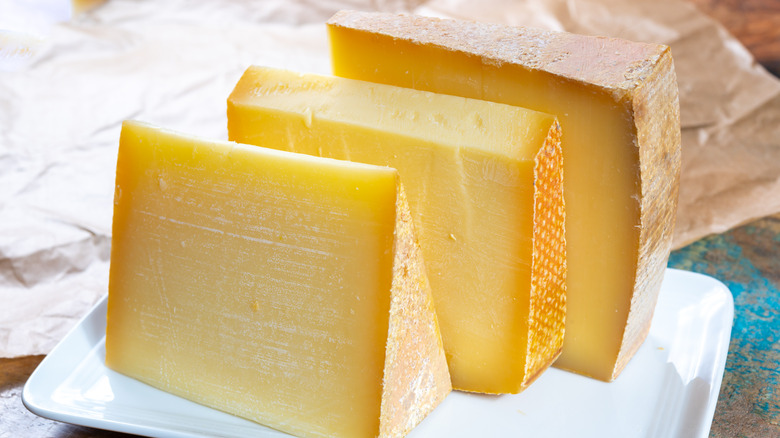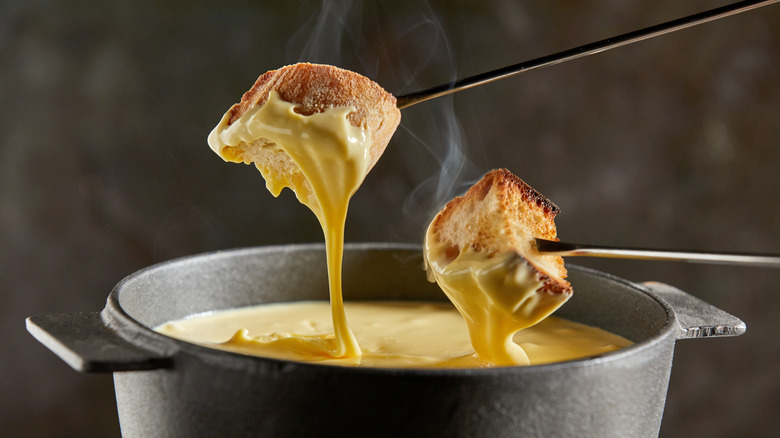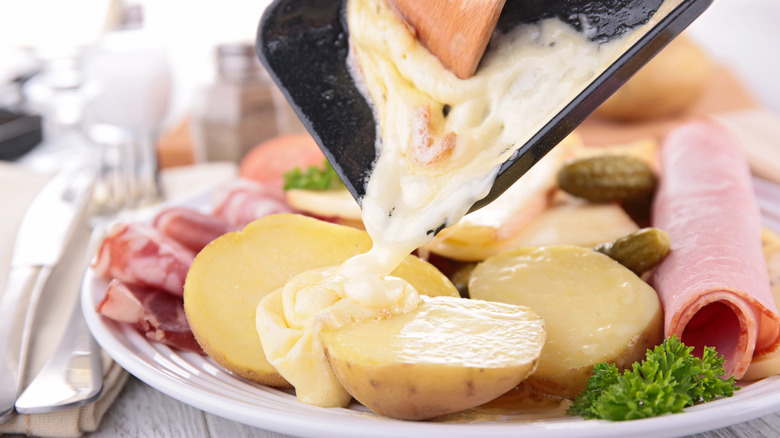Cheese Fondue Vs. Raclette: What's The Difference?
Anyone who grew up in the 1970s is well aware of fondue. And if you missed the decade when communal dining by dipping bread into a shared pot of melted cheese was a thing, check your parent's basement. It's a pretty good bet there's a dusty fondue pot tucked into a corner. Back then, the word fondue was a noun — and a verb. "Let's fondue" was as much a part of our lexicon as "Let's barbecue." Even the iconic early 2000s television hit "That '70s Show" gave fondue a nod when Kitty observed, "You know, I don't know why they call it fondue. They should call it fun-due, 'cause it is fun."
On the other hand, raclette, another made-for-sharing meal centered on melted cheese, remained relatively unknown in the United States until well into the 21st century. Why did fondue catch on, leaving raclette in its dust? That's anybody's guess. According to Culture Trip, both melted cheese-centric dishes originated in Switzerland and are designed for sharing. There are subtle differences, but we have a working theory that may explain fondue's edge over raclette. It all goes back to the fondue pots, so many of us still have tucked in our basements. They were cute and portable. No power cords are required. Just a little sterno flame to keep the cheese warm and melty. In contrast, raclette is a bit more complicated, requiring in-the-moment attention. In other words, fondue is just easier.
What is fondue?
According to Culture Trip, simple cheese fondue is just melted cheese served in a pot with bread cubes for dunking. AlpenWild says modern-day versions of the meal originated in 18th-century Switzerland as a way for agricultural families to stretch their winter larder. The hearty meal also made good use of stale bread. Fondue recipes eventually made their way into French and Belgian cookbooks, marking the acceptance of the simple farmers' dish into well-to-do dining rooms. It wasn't until the 20th century, 1964 to be exact, that fondue gained momentum in the United States after it was introduced in the Swiss Pavillion's Alpine-inspired restaurant during the New York World's Fair.
While modern-day fondue usually begins with a base of nutty Gruyère, some connoisseurs prefer Vacherin, a creamier, semi-hard cheese, according to BBC Good Food. Food History says moitiè-moitiè, a 50-50 blend of Gruyère and Vacherin Fribourgeois, is a popular base. In the Swiss canton of Valais, the go-to blend comprises Gruyère and Raclette, but in Bern, Emmentaler reigns supreme. Recent twists on the classic one-dish meal may incorporate herbs, paprika, cayenne, nutmeg, or mustard.
Ready to dip in? Mind your bread cubes. In Switzerland, it's bad form to lose your bread in melted cheese (via Food History). And don't underestimate the leftovers. When the melted cheese is almost gone, tradition calls for turning up the heat just enough to form a dark crust, the religieuse, on the bottom of the fondue pot. Some say it's the best part of fondue.
What is raclette?
Ready for another take on made-for-sharing melted cheese meals? Consider raclette. According to Culture Trip, it's different from fondue because it's not just about melted cheese; it's about melting — or grilling then shaving — a specific cheese. Plus, there's more leeway when sticking to tradition while experimenting with dippables. While bread is still acceptable, options include deli meats, potatoes, gherkins, and pickled onions. And, to officially qualify as raclette, the cheese should be, you guessed it, raclette.
Despite its lesser-known status in the United States, food historians say raclette actually predates fondue by a lot. According to Culture Trip, the two share a mutual genesis in the Swiss Alps, where farming families created them to make the most of limited winter food sources. But the first references to raclette date to the 13th century and documented mentions of fondue didn't begin until 1699.
A key difference between fondue and raclette is how the cheese is melted for raclette. According to Taste France Magazine, a raclette involves searing a block of cheese over an open flame before scraping the melted portion over boiled potato slices and adding toppings like deli meats or gherkins. Food History says raclette originated among Alpine shepherds who roast potatoes over an open fire while melting raclette cheese on the same platter, then scrape the melted cheese over the potatoes. It's a plausible theory because racler is the French word for "to scrape."


